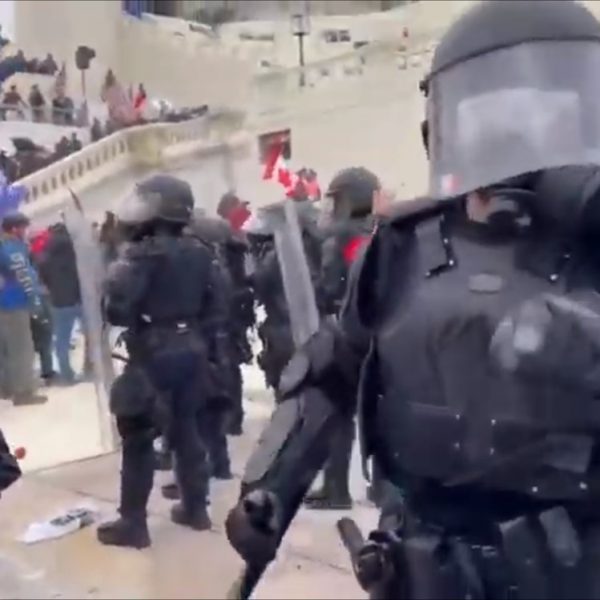Article Written by Nick Mastrangelo and Laura Elizabeth Jenkins
American Gulag obtained this eyewitness footage from an individual working with others to stop a man from being beaten by police. He saw officers outside the Capitol on Jan. 6th striking an unknown man in the head as he lay on the ground in distress.
“This cop wanted to fight us,” he said, referring to the Capitol Police officer below. The officer was not wearing any badge or marker to identify himself.

After protesters called out police and surrounded them, the officers retreated.
“Police are supposed to de-escalate the situation,” the witness said.
However, it appears they were more interested in provoking Trump supporters. They could have worked through the use of force continuum. This protocol-used by all law enforcement agencies-states punching and hitting are not initial tactics police use to diffuse most situations.
You can view the use of force continuum from the National Institutes of Justice here.
This was not the only time police used extreme force before a struggle ensued on the West Terrace archway. This second video shows officers beating a lone man who runs out of the crowd toward law enforcement. He is punched multiple times after he is pinned to the ground. Why wasn’t he just restrained?
Here is a link to the Second Video
There are inconsistencies in Capitol Police’s responses to protesters. While some instances show police behaving aggressively, eyewitnesses Jeff and Ryan Zink detail how Antifa protester Hunter Ehmke is not punished in the same way.
Ehmke jumped on a ledge, kicking and punching out windows. Capitol Police grabbed his legs and restrained him. However, they did not beat him. They arrested him and simply allowed him to leave.
As the day progressed, Capitol Police also did nothing to stop Zach Alam. Alam posed an imminent threat inside the Capitol moments before Ashli Babbitt was killed.
In the still shot below, officers stand next to Alam as he states: “Hey, these guys ain’t the ones that’s the issue.”
They don’t attempt to restrain him, but watch and allow him to speak freely. Alam turns, takes protester Chris Grider’s helmet, and shoves it into the glass door.

As you can see in this video taken by John Sullivan- now property of CNN and NBC- police walk away to the other side of the hall (timestamps 34:39-35:03.)
Police not only show leniency toward Alam, but fraternize with him ten minutes before this. In timestamp 24:20, Alam was congregated in the back of the hallway with police instead of interacting in the crowd. He stood shoulder-to-shoulder with an officer, conversing and whispering in his ear (24:30-25:57.)
At one point, an old man senses something is not right with Alam’s words and actions and confronts him. But the old man was sent away. Another unidentified woman speaks up after Ashli Babbitt is shot, telling Officer K. Yetter she saw Alam hiding in the staircase behind police, changing attire. (Timestamp 37:54.) Officer Yetter yells at the woman, deflecting and ignoring her, while urging her and others to clear the area.
This overfamiliarity toward Alam could explain why Ashli Babbitt was shot by Capitol Police Officer Michael Byrd. Byrd claims one reason he shot Babbitt because she was wearing a backpack. Yet Alam was wearing a backpack too and stood in close proximity to her. Byrd could see Alam just as clearly as Babbitt.
What is the relationship between Alam and officers in the hallway? How did they know one another before the events of Jan. 6th?’
This overfamiliarity also occurs with defendant John Sullivan-a known BLM activist and founder of Insurgence- who organized rallies against President Trump. In this photo below and the CNN & NBC video, Officer K. Yetter listens to Sullivan and appears relaxed in his interactions with him. There is no attempt to silence or restrain him, as with the woman who speaks to him after Ashli Babbitt was shot.
As more inconsistencies surface, our investigative team and members of the public will work to understand exactly what happened on Jan. 6th.


Join the conversation
Please share your thoughts about this article below. We value your opinions, and would love to see you add to the discussion.